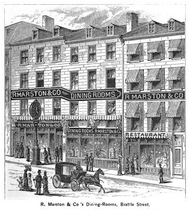Brattle Street (Boston)

Brattle Street, which existed from 1694 to 1962, was a street in Boston, Massachusetts located on the current site of City Hall Plaza, at Government Center.[1][2][3]
History
Around 1853 former Virginia slave Anthony Burns worked for "Coffin Pitts, clothing dealer, no.36 Brattle Street."[4]
Gallery
-

Detail of 1775 map of Boston, showing Brattle St. and vicinity
-

Shelton & Cheever, importers and manufacturers of "engine hose, fire buckets ... harnesses, collars, whips, carpet bags," 1852
-

Funeral of Abbott Lawrence, photo by Southworth & Hawes, 1855
-

Corner of Brattle and Court St., engraving by Winslow Homer, 1857
-

R. Marston & Co. Dining Rooms, ca.1881
-

Overview of Brattle St., ca.1920
-

Brattle Street, Boston, 1962
-

Brattle St., with steps to Cornhill, Boston, 1962
See also
References
- ↑ Boston (Mass.). Street laying-out Dept. (1910), A record of the streets, alleys, places, etc. in the city of Boston (2 ed.), Boston: City of Boston Printing Dept.
- ↑ Walter Muir Whitehill (1968), Boston: a topographical history (2 ed.), Cambridge, Mass: Belknap Press of Harvard University Press, ISBN 0674079507, 0674079507
- ↑ David Kruh (1999), Always something doing: Boston's infamous Scollay Square (Rev. ed.), Boston: Northeastern University Press, ISBN 1555534104, 1555534104
- ↑ Boston slave riot, and trial of Anthony Burns: Containing the report of the Faneuil Hall meeting, the murder of Batchelder, Theodore Parker's Lesson for the day, speeches of counsel on both sides, corrected by themselves, a verbatim report of Judge Loring's decision, and detailed account of the embarkation, Boston: Fetridge and Company, 1854
External links
| Wikimedia Commons has media related to Brattle Street (Boston, Massachusetts). |
- Bostonian Society has materials related to Brattle Street.
| ||||||||||||||||||||||||||||||||||||||||||||||||||||||
Coordinates: 42°21′37.08″N 71°3′28.44″W / 42.3603000°N 71.0579000°W